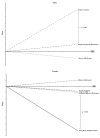Aging Affects Insulin Resistance, Insulin Secretion, and Glucose Effectiveness in Subjects with Normal Blood Glucose and Body Weight
- PMID: 37443552
- PMCID: PMC10341091
- DOI: 10.3390/diagnostics13132158
Aging Affects Insulin Resistance, Insulin Secretion, and Glucose Effectiveness in Subjects with Normal Blood Glucose and Body Weight
Abstract
Aim: Several studies have demonstrated that factors including diabetes, including insulin resistance (IR), glucose effectiveness (GE), and the first and second phase of insulin secretion (FPIS, SPIS) could easily be calculated using basic characteristics and biochemistry profiles. Aging is accompanied by deteriorations of insulin resistance (IR) and insulin secretion. However, little is known about the roles of aging in the different phases of insulin secretion (ISEC), i.e., the first and second phase of insulin secretion (FPIS, SPIS), and glucose effectiveness (GE).
Methods: In total, 169 individuals (43 men and 126 women) recruited from the data bank of the Meei-Jaw (MJ) Health Screening Center and Cardinal Tien Hospital Data Access Center between 1999 and 2008, with a similar fasting plasma glucose (FPG: 90 mg/dL) and BMI (men: 23 kg/m2, women 22 kg/m2) were enrolled. The IR, FPIS, SPIS, and GE were estimated using our previously developed equations shown below. Pearson correlation analysis was conducted to assess the correlations between age and four diabetes factors (DFs: IR, FPIS, SPIS, and GE). The equations that are used to calculate the DF in the present study were built and published by our group.
Results: The age of the participants ranged from 18 to 78 years. Men had higher FPIS but lower HDL-C levels than women (2.067 ± 0.159, 1.950 ± 0.186 μU/min and 1.130 ± 0.306, 1.348 ± 0.357 mmol/dl, accordingly). The results of the Pearson correlation revealed that age was negatively related to the IR and GE in both genders (IR: r = -0.39, p < 0.001 for men, r = -0.24, p < 0.003 for women; GE: r = 0.66, p < 0.001 for men, r = 0.78, p < 0.001 for women). At the same time, the FPIS was also only found to be negatively correlated with age in females (r = -0.238, p = 0.003), but there was no difference in the SPIS and age among both genders.
Conclusions: We have found that in Chinese subjects with a normal FPG level (90 mg/dL) and body mass index (men: 23 kg/m2, women: 22: kg/m2), age is negatively related to the IR and GE among both genders. Only the FPIS was found to be negatively related to age in women. The tightness of their relationships, from the highest to the lowest, are GE, FPIS, and IR. These results should be interpreted with caution because of the small sample size.
Keywords: first-phase insulin secretion; glucose effectiveness; insulin resistance; second-phase insulin secretion; type 2 diabetes.
Conflict of interest statement
The authors declare no conflict of interest.
Figures
Similar articles
-
The relationships between hemoglobin and insulin resistance, glucose effectiveness, and first- and second-phase insulin secretion in adult Chinese.Arch Endocrinol Metab. 2019 Sep 2;63(5):509-515. doi: 10.20945/2359-3997000000169. eCollection 2019. Arch Endocrinol Metab. 2019. PMID: 31482956 Free PMC article.
-
Effect of body mass index on diabetogenesis factors at a fixed fasting plasma glucose level.PLoS One. 2018 Jan 29;13(1):e0189115. doi: 10.1371/journal.pone.0189115. eCollection 2018. PLoS One. 2018. PMID: 29377927 Free PMC article.
-
Association between gamma-glutamyl transferase and diabetes factors among elderly nonobese individuals.Medicine (Baltimore). 2025 Mar 21;104(12):e41913. doi: 10.1097/MD.0000000000041913. Medicine (Baltimore). 2025. PMID: 40128013 Free PMC article.
-
Relationships between white blood cell count and insulin resistance, glucose effectiveness, and first- and second-phase insulin secretion in young adults.Medicine (Baltimore). 2020 Oct 23;99(43):e22215. doi: 10.1097/MD.0000000000022215. Medicine (Baltimore). 2020. PMID: 33120730 Free PMC article.
-
Influence of Diabetogenic Factors on Fasting and Postprandial Glucose Levels in Patients with Type 2 Diabetes Mellitus.Metab Syndr Relat Disord. 2019 Nov;17(9):465-471. doi: 10.1089/met.2019.0028. Epub 2019 Oct 7. Metab Syndr Relat Disord. 2019. PMID: 31589092
Cited by
-
The Role of S6K1 in Aging and Alzheimer's Disease: Mechanistic Insights and Therapeutic Potential.Int J Mol Sci. 2025 Jun 20;26(13):5923. doi: 10.3390/ijms26135923. Int J Mol Sci. 2025. PMID: 40649702 Free PMC article. Review.
-
GCKR Polymorphisms Increase the Risks of Low Bone Mineral Density in Young and Non-Obese Patients With MASLD and Hyperuricemia.Kaohsiung J Med Sci. 2025 Jun;41(6):e70017. doi: 10.1002/kjm2.70017. Epub 2025 Apr 9. Kaohsiung J Med Sci. 2025. PMID: 40202351 Free PMC article.
-
Relationship between Abdominal Volume Index and Body Adiposity Index and Scales of Insulin Resistance and Metabolic Syndrome.Diagnostics (Basel). 2023 Oct 31;13(21):3356. doi: 10.3390/diagnostics13213356. Diagnostics (Basel). 2023. PMID: 37958252 Free PMC article.
-
Unraveling the Mystery of Insulin Resistance: From Principle Mechanistic Insights and Consequences to Therapeutic Interventions.Int J Mol Sci. 2025 Mar 19;26(6):2770. doi: 10.3390/ijms26062770. Int J Mol Sci. 2025. PMID: 40141412 Free PMC article. Review.
-
Geroprotective applications of oleuropein and hydroxytyrosol through the hallmarks of ageing.Geroscience. 2025 May 27. doi: 10.1007/s11357-025-01697-4. Online ahead of print. Geroscience. 2025. PMID: 40425998 Review.
References
-
- Chockalingam N., Gatt A., Formosa C., Nachiappan N., Healy A. Provision of assistive devices for people with diabetes at risk of mobility impairment. World Health Organ. 2019;2019:466–470.
-
- Tseng C.-H. The epidemiologic transition of diabetes mellitus in Taiwan: Implications for reversal of female preponderance from a national cohort. Open Diabetes J. 2009;2:18–23. doi: 10.2174/1876524600902010018. - DOI
Grants and funding
LinkOut - more resources
Full Text Sources
Miscellaneous


